

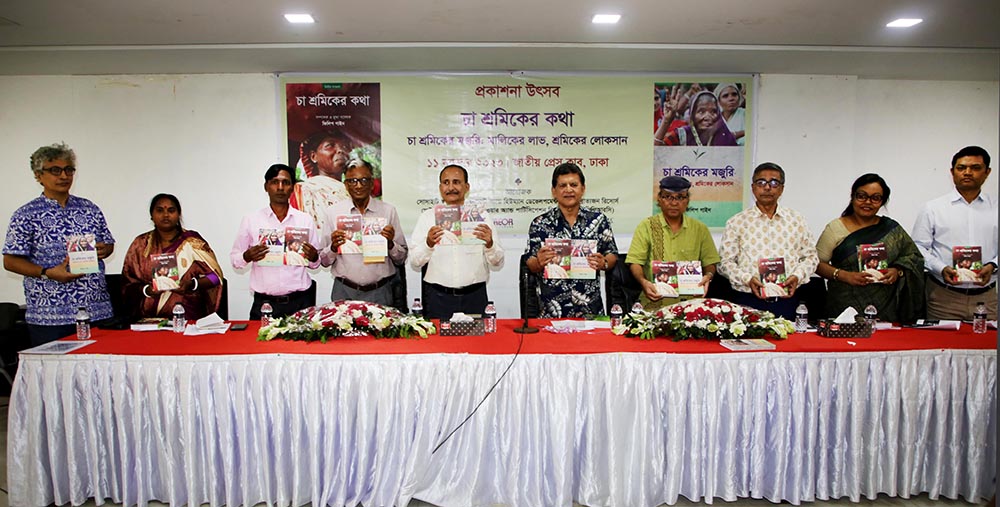
Books Explain Tea Workers’ Deprivation
The story of tea plantation workers of Bangladesh is one of captivity, deprivation and exploitation that has no end. Descendants of the indentured labour force, they remain tied to the tea gardens. Most of them are non-Bangalee, lower caste Hindu, Adivasis, Bihari Muslims, and their ethnic composition is unique.
Society for Environment and Human Development (SEHD) has been closely following the tea workers and the tea industry for two decades now. Its research, investigation and visual documentation have resulted in volumes of publications, investigative reports and three documentary films.
Its latest two books—Cha Sramiker Katha (The Story of the Tea Workers) edited by the writer and Cha Sramiker Mojuri: Maliker Labh, Sramiker Loksan (Wages of Tea Workers: Owners Win, Workers Lose) authored by the writer—were launched on 11 November 2023. While Cha Sramiker Katha is about the overall condition of the tea workers and the tea industry of Bangladesh, the other book concentrates on the tea workers’ wages and their unprecedented 19-day strike in August 2022 for a daily cash pay of BDT 300.
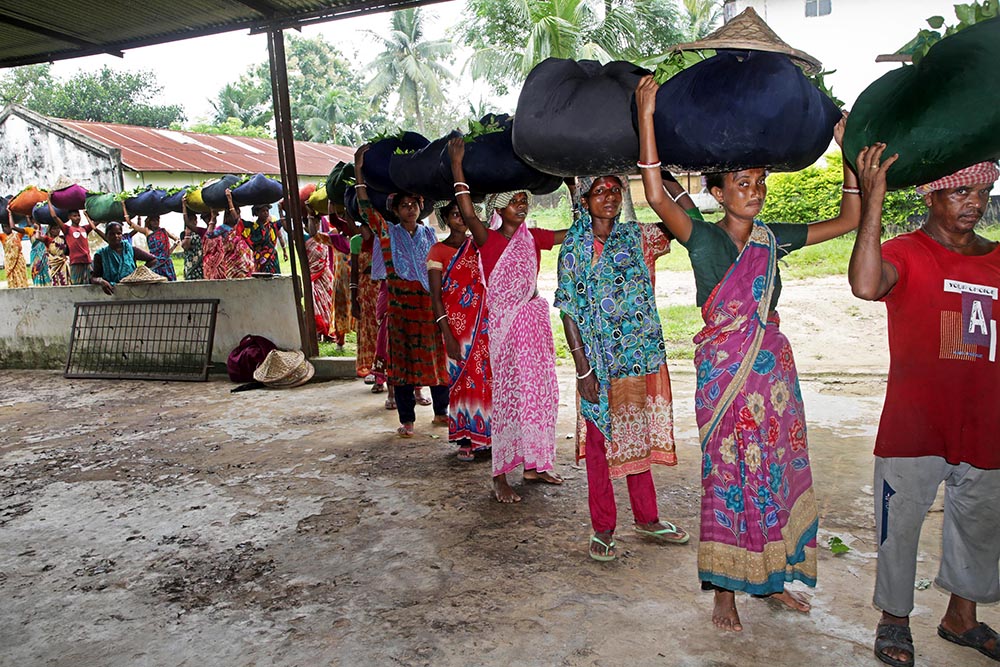
A group of tea workers including their top leaders traveled to Dhaka to attend the book launch ceremony and narrated their ordeals. A panel of economists, academics, and trade union leaders spoke strongly in favour of the tea workers. They concurred with messages that the books transpire and added their insights.
“Soon after the release of the second edition of Cha Sramiker Katha in 2022, an unprecedented 19-day strike appeared as an upheaval in the tea gardens. The strike came to end only after Prime Minister Sheikh Hasina intervened and fixed the daily cash wage of workers at BDT 170, a rise from BDT 120. Although this increase did not fulfill the tea workers demand of BDT 300 in daily cash pay, the tea workers accepted it and went back to their work. Cha Sramiker Mojuri: Maliker Labh, Sramiker Loksan reviews and analyzes the events leading up to and after this unprecedented strike,” said Philip Gain, author and editor of the books and director of SEHD.
Fair wage is always the most pertinent issue and concern of the tea workers. “It is at the incitement of the owners of the tea gardens that increase of wage fell much short of what we demanded,” said Nripen Paul, the acting general secretary of Bangladesh Cha Sramik Union (BCSU), the lone trade union in the tea industry. It is also the largest trade union in Bangladesh.
“We are deprived of our legitimate benefits including legal entitlements and protection,” added Sreemoti Bauri, vice president of Juri Vally of BCSU, one of the seven valleys in the tea growing districts.
The second book on workers’ wage and unprecedent strike of August 2022 that brought the tea industry to a standstill elaborately discusses the wage issues of the tea workers. In this book, the author explains how the owners’ calculation of daily wage of a worker that amounts to more than BDT 500 (USD 4.5) is seriously flawed. Benefits that the labour legislation allows to be added to the cash pay is less than BDT 300 (USD 2.7).
This wage is around half of what an agricultural worker in Bangladesh gets and lot less than what lowest grade workers in other sectors get.
“The employers unjustly calculate the wages. They ignore the labour law in their calculation,” said Barrister Jyotirmoy Barua, a lawyer practicing in the Supreme Court of Bangladesh. “This attitude of the employers must change.”
On the minimum wage issue, Professor M.M. Akash, Chairman of Bureau of Economic Research (BER) of Dhaka University said, “Whenever it comes to increase tea workers’ wage, the owners say it is not possible. It is an eyewash.” He directed a question to the owners, “Why, you big companies, are taking over the tea gardens if you are not making good profits? If you do not make profit, why would you invest in the tea industry?”
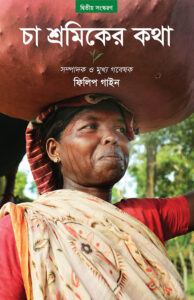 “Tea workers’ job requires hard work. So, they should be paid enough so that they are able to nourish themselves adequately to be strong enough to work for eight hours. This major issue has to be taken into account while fixing their minimum wage,” Prof. Akash added.
“Tea workers’ job requires hard work. So, they should be paid enough so that they are able to nourish themselves adequately to be strong enough to work for eight hours. This major issue has to be taken into account while fixing their minimum wage,” Prof. Akash added.
“An audit of profit and loss of each tea garden must be carried out and made public before the owners claim ‘we are unable to pay more than this’. Because their luxurious lifestyle is telling something else,” remarked the editor of United News of Bangladesh (UNB), Mr. Farid Hossain.
Prof. Akash also pointed out how the poor economic status of the tea workers affects their fate. “If the workers had been financially well-off their 19-day strike would have lasted longer and workers could secure BDT 300 instead of BDT 170. Unfortunately, they are the ‘poorest among the poor’.”
Dr. Hossain Zillur Rahman, a senior economist and chair of the book launch, talked on how important it is to pay just wages to the tea workers. “We are dreaming of turning Bangladesh into a middle-income country. To see that dream come true, we must free our policy-sphere,” said Dr. Rahman. “We cannot become middle-income country with cheap labour such as the tea workers.”
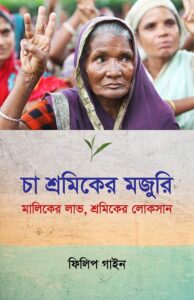 Slashing of tea workers’ arrear is another facet of deprivation alongside their unjust wage. After prime minister fixed their daily cash pay at BDT 170, they were supposed to receive around BDT 30,000 in arrear for 20 months. But each got BDT 11,000. “Such a big slash has been possible because of maneuvering of the employers and failure of the union leaders in the tea sector,” Prof. Akash observed.
Slashing of tea workers’ arrear is another facet of deprivation alongside their unjust wage. After prime minister fixed their daily cash pay at BDT 170, they were supposed to receive around BDT 30,000 in arrear for 20 months. But each got BDT 11,000. “Such a big slash has been possible because of maneuvering of the employers and failure of the union leaders in the tea sector,” Prof. Akash observed.
“The tea workers do not have much liberty to choose their work independently outside the garden. To try that they have to leave their houses inside the plantation, which they cannot afford because the country outside the tea gardens is unknown to them and they are completely landless,” remarked Prof. Akash. “All these factors compel them to remain tied to the tea gardens at least to secure a place to live. This condition restricts them from competing for jobs with others outside the plantation.”
Barrister Barua echoed this land rights issue in his discussion: “If owners follow Section 32 of labour law diligently, then why do they not pay heed to the benefits provided by Fifth Schedule of the Labour Rules 2015? Law cannot be used only to the employers’ convenience. The industry will develop in the right direction only when owners will consider workers as assets, not just the gardens.”
“Two books that are launched today are encyclopedic for journalists,” observed Mr. Farid Hossain. “While exploitation and hardships of the tea workers are documented in these books, some of their success stories are also highlighted. Our journalists should also focus and report such human-interest stories of tea workers.”
On the significance of struggle of the tea workers in the field, Dr. Hossain Zillur Rahman said, “When the fight in field is joined by the fight with knowledge at the national level, the voice of the tea workers gets stronger. And I think with the books launched today, we have set the stage for such a collaboration. So, let us leave this publication ceremony with a feeling of strength.”
“The books launched have unveiled the tea workers situation,” said Tapan Datta, a life-long labour leader and adviser to BCSU since 1970. “These publications are another struggle like that of tea workers. It is for SEHD that tea workers’ land rights issues have come to the fore.”
Among others who spoke at the book launch included Prof. Tanzimuddin Khan and Prof. Sanjida Akhter of Dhaka University; Dhona Bauri, BCSU leader; and Abdullah Kafee of CPB. by Fahmida Afroze Nadia with Philip Gain
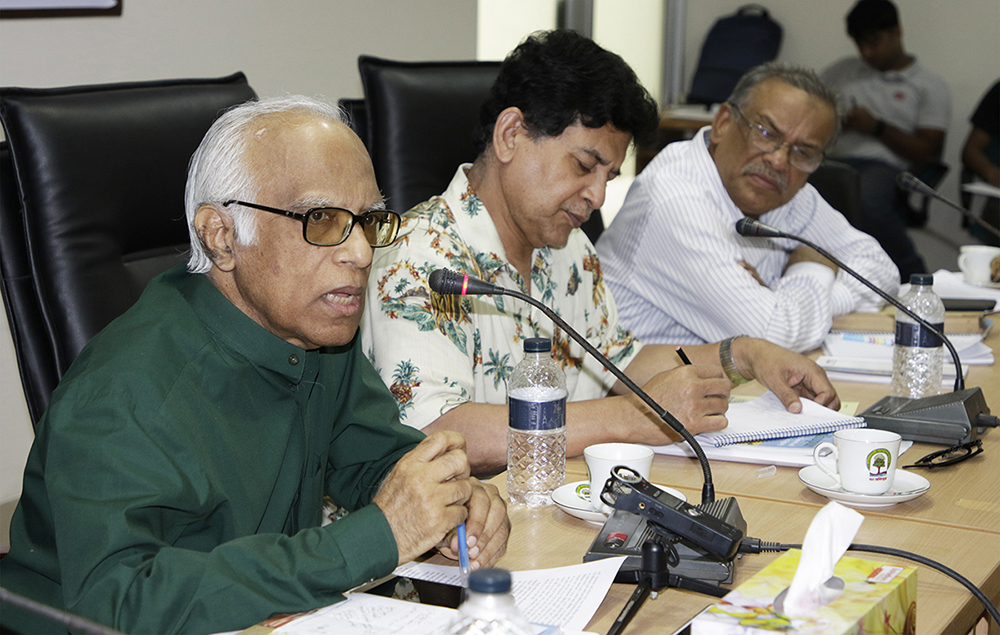
Roundtable Discussion
A roundtable discussion titled, “Modhupur Sal Forest: Its Demise, Demographic Changes and Customary Land Rights” was jointly organized by Society for Environment and Human Development (SEHD) and Power and Participation Research Centre (PPRC) on 29 July 2019 at Ban Bhaban in Agargaon. Read more…

Prof. Wahiduddin Mahmud, delivering his speech as the chief guest at the roundtable. On his left are Dr. Hossain Zillur Rahman, chair and Md. Yunus Ali, former Chief Conservator of Forests.
Modhupur Sal Forest: Its Demise, Demographic Changes and Customary Land Rights
“The government should formulate national policy reconciling local and other interest groups to sustain the remaining forests. However, without good governance those policies may not work unless laws are enacted to safeguard the forest and its people,” said Professor Wahiduddin Mahmud at a roundtable discussion titled, “Modhupur Sal Forest: Its Demise, Demographic Changes and Customary Land Rights” organized jointly by Society for Environment and Human Development (SEHD) and Power and Participation Research Centre (PPRC). The roundtable discussion was held on 29 July 2019 at Ban Bhaban in Agargaon.
Prof. Mahmud, chief guest of the discussion also said, “The country’s interest depends on the preservation of the forest resources even though the land and forest resources in our country are scarce. However, forest resources are decreasing in the country, particularly in Modhupur. Now, we are in a situation where blaming each other is fruitless. The government, with comprehensive plan, can save what remains of the forest and solve complex land issues in Modhupur.”
On his reflection on the land issue, Prof. Mahmud said, “Because the land is a valuable asset, we must ensure legitimate interest of original inhabitants of Modhupur through discussion.”
The participants at the roundtable.
In his keynote presentation, Philip Gain, Director of SEHD and team leader, shared the key finds of a household survey in 44 forest villages in Modhupur sal forest area. “The key objectives of the survey were to expose factors that underlie the dramatic changes in the Modhupur forest and forest villages and generate baseline data on the demographic changes and socio-economic conditions of forest people,” said Gain. “The Garo and Koch, once exclusive occupants of Modhupur sal forest are nowadays far outnumbered by the Bangalees. Among the 11,048 households surveyed in five unions (Kuragachha, Fulbagchala, Beribaid, Sholakuri and Aronkhola), 64.61% are Bangalees and 35.39% are Garos.”
“Land possession and ownership is one of the most critical issues in Modhupur forest villages. Only 13% Bangalee and 4.19% Garo households have title deeds (CS or RoR) for their homestead land in the forest villages. This means majority of households have homesteads on customary land. Besides, smaller percentage of households has title deeds for other types of land (high land and low land),” reported Gain. “Social forestry has, in fact, been a major source of forest cases and tension among the local people. In the 44 forest villages surveyed, the number of forest cases found is 3,029, of which 2,157 are against the Bangalees and 872 against the Garos. It is necessary to take proper initiative to save the forests and settle the false forest cases.”
Yunus Ali, former Chief Conservator of Forests (CCF) of the Forest Department denied the allegation against Forest Department and social forestry projects for the destruction of forests in Modhupur. “Destruction of forest has been going on since long before the introduction of social forestry. It is not right to blame social forestry alone for the destruction of forests. Besides, social forestry has been successful all over the country except in Modhupur,” explained Ali. “The destruction of forest of our country is linked to the pattern of land use. With the demise of forest land, agricultural lands have increased.”
Theophil Nokrek, a Garo writer, demanded for customary land rights of the Garos and settle the false forest cases. He suggested that dialogues be arranged between the Forest Department
Garo women returning home with head load of firewood they have collected from bushes. With most of the Modhupur sal forest despoiled, their traditional gathering from forest has become meager and difficult.
and the people who live in the forest to settle the existing land disputes and tension among the forest villagers. He also urged the government to recognize customary land rights of the Garos and others in accordance with the ILO convention 107, which Bangladesh has ratified.
Eugin Nokrek, president, Joyenshahi Adivasi Samaj Kallyan Shangstha was critical on the intervention of the Asian Development Bank (ADB) and World Bank in the Modhupur sal forest. “The social forestry project initiated by ADB was a mistake. The project was implemented clearing the natural forest,” Nokrek asserted. Nokrek demanded for the Sulekha Mrong, executive director of Achik Michik Society called for saving the sal forest. “We need mental orientation to save the forest. Without it, Modhupur forest will not survive,” said Mrong.
Dr. Tanzimuddin Khan, associate professor, Department of International Relations of University of Dhaka was critical in his reflection on the Forest Department, the multinational corporations and lucrative development projects in the country. He said, “We shall isolate the forest people if we see them through the lens of zamindari ideology in the Mughal era. The development projects financed by the donor agencies and multinational corporations strategically ignore the issue of forest conservation. The Forest Department must think critically and examine the adverse effects before implementing forestry projects.”
Dr. Hossain Zillur Rahman, the chair of the roundtable discussion and executive chairman of Power and Participation Research Centre (PPRC) in his concluding remarks called for affirmative discussions and reconciliation of different interests between the Forest Department and forest people in Modhupur. “We find three interests regarding the Modhupur forest—forest conservation, agriculture and the demands of the people living there. Modhupur forest will not survive without the coordination of these interests. We have to understand these interests first and then move to a sustainable solution through discussion,” explained Rahman.
In his reflection on the customary land right of the ethnic people in Modhupur, Dr. Rahman said, “The majority of the ethnic people living in Modhupur sal forest area do not have title deeds for their land. If the land issues cannot be solved by means of title deeds, it can be solved from the perspective of Sustainable Development Goals agenda.” He advised the Forest Department to solve compoundable forest cases through discussion and scale up the Garo representation among the community forest workers (CFWs) to save the forest from extinction. He suggested for a tripartite survey on land possession among the Forest Department, Garos and Bangalees.
Others who spoke at the discussion are Dr. Mohammed Zahirul Haque, Assistant Chief Conservator of Forest (ACCF), Forest Department; Harun-Ur-Rashid, Divisional Forest Officer (DFO), Tangail Forest Division; Ajoy A. Mree, president, Adivasi Cultural Development Forum; Bikson Nokrek, UP member, Sholakuri Union; Abdul Majid Mallick, development consultant; Farid Uddin Ahmed, executive director, Arannayk Foundation; Akter Hossen, chairman, Sholakuri Union Parishad; and Md. Abdur Rahim, chairman, Aronkhola Union Parishad.
Report by Rabiullah and James Sujit Malo
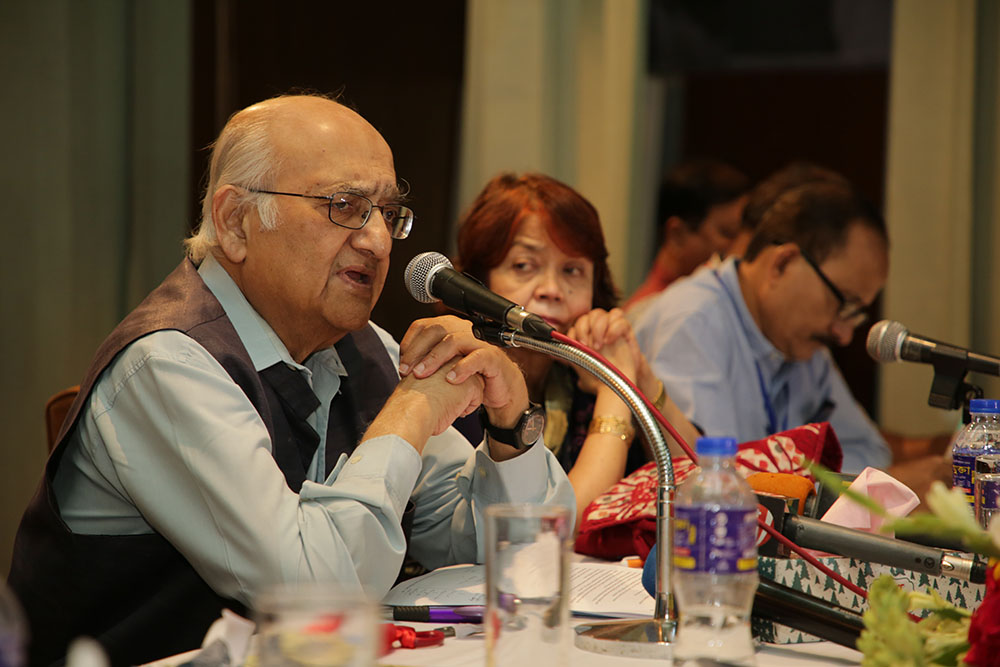
National Convention in Dhaka Held
Four organizations organized a national convention on “Discrimination, Exclusion and Rights of the Marginal and Excluded People” in LGED Bhaban, Agargaon, Dhaka on 20 and 21 June 2019 to highlight the issues of social exclusion and discrimination in Bangladesh and explore a roadmap to lift these communities out of poverty and enshrine their human rights. The participants to the convention—as many as 400—represented more than 50 ethnic and marginal communities.
Discrimination, Exclusion and Rights of the Marginal and Excluded People
Professor Rehman Sobhan, chief guest, speaking at the inaugural session.
A significant percentage of 165 million people of Bangladesh face discrimination and exclusion—socially, economically, politically—for various reasons such as ethnic identity, situations close to slavery, occupation, casteism, culture, geographical locations, landlessness and eviction from their homesteads. They are, on the one hand, deprived of equal opportunities guaranteed by the constitution to all citizens; on the other, they are handicapped by a series of social, economic and political problems. The marginal and excluded people among the citizens of Bangladesh include different communities who are victims of casteism, ethnic minority groups, tea communities, Bede, Bihari, sex workers, bisexual or transgender people, Kaiputra, Jaladas, people with disability, people living on the fringe or in char land (river island), Bawali and Rohingyas. The people of all these ethnic identities and occupational groups are at risks of being excluded because they are already deprived of their legitimate rights. The people who are marginal and excluded face deprivation in terms of leading normal life, secure permanent jobs, income, resources, access to loans, housing, education, skills, cultural capital, welfare state, citizenship and equal rights before law, democratic participation, human treatment and dignity.
Four organizations implementing the project organized the convention in LGED Bhaban, Agargaon, Dhaka on 20 and 21 June 2019 to highlight the issues of social exclusion and discrimination in Bangladesh and explore a roadmap to lift these communities out of poverty and enshrine their human rights. The participants to the convention—as many as 400—represented more than 50 ethnic and marginal communities.
The convention had begun with an inaugural session in which a panel of experts spoke. They reflected on the keynote paper presented by Philip Gain and shared their expert opinions and insights from their lifetime professional experience to set the tone of the subsequent workshops in the two-day convention and to put the discussion on exclusion challenges in perspective.
Professor Rehman Sobhan, an eminent economist of the country and the chief guest at the inaugural session, was apprehensive in his reflections on exclusion challenges as well as marginalization in Bangladesh. “Unlike India, Bangladesh has fewer resources and political power concerning the excluded and marginal people,” said Prof. Sobhan. “The marginal communities must acquire political power along with increasing their capabilities to end discrimination against them.”
He made several recommendations to enshrine the rights of the marginal communities and tackle the exclusion challenges. “Protection of customary rights to land of the Adivasis according to legal instruments is necessary. There are several organizations working on it. An institutional framework consisting of partnerships among the civil society organizations and the political groups is crucial to protect their land,” suggested Prof. Sobhan.
Prof. Sobhan stressed on the modernization of tools for different occupational groups—Harijans, Kaiputra and Jaladas and urged the government and development organizations to adopt innovative approaches, e.g. small-enterprises concerning specific occupational groups to empower these communities. “The government has different social safety net programmes. Ensuring participation of the marginal and excluded groups in these programmes is crucial. It is also important to allocate sufficient amount for them in the national budget and think innovative ways to scale up their capacity,” said Prof. Sobhan.
 The guests at the inaugural session are showing the book, “Modhupur: The Vanishing Forest and Her People in Agony” after its official launch.
The guests at the inaugural session are showing the book, “Modhupur: The Vanishing Forest and Her People in Agony” after its official launch.
Prof. Rounaq Jahan, distinguished fellow at Centre for Policy Dialogue (CPD), was critical while reflecting on the marginal and excluding groups in Bangladesh. “Anthropological survey like in India is absent in Bangladesh to make the ethnic and excluded communities visible,” Prof. Jahan pointed out. “The ethnic and marginal communities have different problems and no single solution can help them tackling the exclusion challenges.”
She stressed on understanding the problem trees of these communities and urged the government to take affirmative actions for them. She also stressed on the protection of customary rights of the ethnic communities on land. “Formation of a separate ministry and separate land commission that will work with other related ministries is necessary for the protection of land of ethnic communities of the plains. Besides, an umbrella organization is required to scale up their bargaining skills.” Prof. Jahan, concerned about the situation of the tea workers exclaimed, “From the British era until now, owners have changed in the tea garden. However, the life of the tea workers is still the same.”
In his keynote presentation, Philip Gain, gave an overview of the ethnic and excluded groups and people who face discrimination are at the risk of exclusion. “There are many communities other than adivasis in Bangladesh who face discrimination and social exclusion due to ethnic identities, religions, occupations, casteism and captivity. These communities include tea workers, Harijans, Bede, sex workers, Bihari, Kaiputra (pig rearing community), Jaladas and Rishi. Many of them are considered untouchables,” explained Gain.
Gain stressed on generating accurate statistical accounts on the ethnic and marginal communities. “In Bangladesh, the state agencies lack right orientation and methodologies to generate accurate statistics on the ethnic and marginal communities,” alerted Gain. “The government, in a gazette notification dated 19 March 2019, has published a list of 50 ‘khudra nri-goshthi’ (small ethnic groups) to replace the schedule in the Khudra Nri-goshthi Sangskritik Pratisthan Ain, 2010 (The Small Ethnic Groups Cultural Institution Act 2010). However, we have found around 80 communities only in the tea gardens. Twenty-three of them are on new government list as small ethnic groups. The argument for inclusion of many small ethnic groups apply to more than 50 other groups who are not on the government list yet.”
Gain stressed on the protection of land rights of the adivasis. He was critical about the functioning of the land commission in CHT. “The land issue in Modhupur sal forest area is complex. Only the Garos and Koch were the exclusive occupants of the Modhupur forest at one time of history. But the demographic picture has dramatically changed today. In our recent surveys in 44 forest villages in Modhupur, we have found out that 61.11% of the inhabitants in these villages are Bangalees, 33.47% are Garos and 5.42% are Koch. Only 13% of the Bangalee households have title deeds (CS and RoR) for their homestead land, which is only 4.19% for the Garos. The percentage of households having recorded high or chala land is much lower—4.18% (Bangalees and Garo together). In case of high or chala land again while 4.83% of the Bangalee households have such recorded land, it is only 2.61% for the Garo households. In case of low or baid land the Garo households are ahead of the Bangalees—while 9.67% of the Bangalee households have recorded low land, 11.17% of the Garo households have such land.” Gain informed that forest cases skyrocketed in the forest villages since the introduction of social forestry in place of natural forest. Gain demanded for a separate land commission for the plains land Adivasis.
In his welcome address, Joyanta Adhikari, executive director, Christian Commission for Development in Bangladesh (CCDB) spoke on the significance of mainstreaming the ethnic and marginal communities and ensuring their inclusion in the national budget and planning. He demanded for the inclusion of all small ethnic communities of the country in the upcoming national census 2021. Besides, he stressed on the importance of formulating specific policies for the protection of land of ethnic communities.
Rambhajan Kairi, general secretary of Bangladesh Cha Sramik Union (BCSU), spoke on the tea workers’ condition. “Many of the communities living in the tea gardens do not have state recognition. Their invisibility indicates their identity crisis. Their languages and cultures are also in danger of extinction. They fall behind the majority Bangalee population,” explained Kairi. He also spoke on the generational deprivation of the tea workers and discrimination in the Bangladesh Labor Law 2006. “Bangladesh Labour Law 2006 is highly discriminatory. According to the law, a tea worker has to vacate his or her land on which s/he has lived for generations. The tea workers do not own any land. Where will they go after they vacate their only living place?” questioned Kairi.
Dr. Harishankar Jaladas, a novelist and writer, reflected on history of casteism and social exclusion in India. “There are many communities in Bangladesh that lag behind in comparison to the majority Bangalee population. Their access to government services is limited. A country will not culturally, economically and socially develop if the marginal communities are left behind,” exclaimed Dr. Jaladas.
Audrey Maillot, team leader, Governance, Delegation of the European Union shared EU’s views on marginal and excluded communities. “European Union supports civil society organizations to get organized and promote human rights. It is determined to give voice to the voiceless. This national level convention is a platform for the representatives of the marginal and excluded communities to share how they feel.”
The chair of the inaugural session, Dr. Hossain Zillur Rahman, executive chairman of Power and Participation Research Centre (PPRC) and former advisor to the caretaker government, reminded in his remarks: “Leaving no one behind has become a state agenda. It is now being pronounced at every sphere. However, the ethnic and marginal communities are invisible in the national statistics, social thoughts and they lack state attention,” explained Dr. Rahman. “The main objective of our initiative is to make the marginal and excluded communities visible. Besides, it is also important to break the cycle of exclusion and challenges these communities face.”
“Saving the environment has become a national agenda across the world. The Adivasis of Bangladesh have experience of living in the forest for hundreds of years. It is important to understand their traditional knowledge and use them to find a sustainable solution for the coexistence of human and nature,” alerted Dr. Rahman. He also stressed on the establishment of a resource centre on ethnic and excluded communities, which will work as a knowledge hub on their life, society and the rights.
Marginality and Exclusion Issues Discussed
Seven parallel sessions held during the two-day convention covered wide-ranging issues of the marginal and excluded communities—identity, culture and languages; ways to achieve Sustainable Development Goals (SDGs) for the marginal and excluded communities; understanding international instruments and national laws; innovative approaches in understanding and analysing the problems of the excluded communities; understanding micro-realities of forest and commons in Modhupur; land rights of the marginal and excluded communities; strategies for protection of the marginal and excluded communities. In the final plenary sessions reports of parallel session were presented.
Dhaka Declaration
‘Leaving no one behind’ is commitment that Bangladesh makes for achieving the SDGs agenda. Keeping this in mind, the convention came to an end with the adoption of Dhaka declaration. The declaration calls for elimination of all forms of discrimination. The participants to the convention—around 400 representatives from more than 50 ethnic and excluded communities—gave their consent to Dhaka declaration. A committee, formed in advance, drafted the declaration taking into consideration that the issues, concerns, demands and recommendations raised and made in conventions, consultations and workshops throughout the project period. Key demands and recommendations made on issues in the declaration are state recognition of the ethnic and excluded communities, official mapping to generate accurate statistics on their number and population, constitutional recognition of communities that are not Bangalees, legal protection, necessary amendment to discriminatory labour law, ending wage deprivation and income disparity, ensuring education to the children of the marginal and excluded communities, formation of a separate land commission for the plains land Adivasis and tea workers to grant them land rights, scaling up attention to decent work condition particularly of the tea workers, recognition of customary land rights, state and non-state actions against land grabbing, recognition of mother languages, rapid settlement including compounding of forest cases, and budget allocation for scaling up skills of communities that have fallen behind.
Celebration of Culture
A cultural festival was piggybacked with the convention. In the evenings of 20 and 21 June 2019 seven cultural teams from among the Garo, Santal, Telegu, Mandraji, Rajbhar, Monipuri, Baraik, Mahle, Paharia communities and one team from Transgender (Hijra) performed their unique traditional songs and dances. The Santal cultural team welcomed the guests with famous Dasai (welcome dance) of the Santals in the morning of 20 November 2019.
The cultural teams stood out because of their colorful costumes and unique performances. The magic of Babul Rabidas added an extra flavour in both convention and cultural evenings. The Mahle and Paharia cultural teams portrayed their traditional occupations and religious beliefs through dances and songs. The stick dances of artists from tea garden were stunning.
What amazed the visitors to the cultural evenings were lectures on resistance of ethnic and marginal communities through cultural forms, research and writing. On the first day Professor Tahmina Ahmed of University of Dhaka spoke on Santal resistance in the British era through cultural forms. She stressed on the importance of history in developing resistance. “History is the tool of resistance. We must rely on our history to stand for our rights. The last word of our resistance should be equality where no one shall be regarded as marginal or excluded,” exclaimed Professor Ahmed.
On the second day of the cultural festival researcher and Novelist Dr. Harishankar Jaladas spoke on resistance of the marginal people through research and writing. He emphasized on
 Mahale cultural team at the cultural program.
Mahale cultural team at the cultural program.
building real life characters in novel to represent the marginal and excluded communities. Researcher and educationist from Dinajpur, Dr. Masudul Hoq also spoke on the second day.
Report by James Sujit Malo and Rabiullah with Philip Gain
Dhaka Declaration-2019
Adopted at the National Convention on Discrimination,
Exclusion and Rights of the Marginal and Excluded People
Held on 20 and 21 June 2019
We, different ethnic and marginal people, tea workers, Harijans, Rishi, Jaladas, Kaiputra, Bede, sex workers, Robidas, Transgender (Hijra), Bihari, human rights defenders, government and non-government organizations and researchers who have been working together for a long time and participated in the national convention on discrimination, exclusion and rights of the marginal and excluded people organized by Society for Environment and Human Development (SEHD), Power and Participation Research Centre (PPRC), Christian Commission for Development in Bangladesh (CCDB) and Gram Bikash Kendra (GBK) on 20-21 June 2019 at LGED Bhaban, Agargaon, Dhaka have adopted this declaration, which will be considered as Dhaka Declaration.
A significant percentage (approximately six millions) of 165 million people in Bangladesh face discrimination and indignity for their ethnic identity, occupation, casteism, untouchability, cultural differences, geographic locations, captive situation and various other reasons. Bangladesh has drawn attention of the world as a role model of development. However, the marginal people have difficulties in treading the same path of development as equal citizens of Bangladesh. As a consequence, these communities live in distress under extreme poverty. Bangladesh cannot be a good model of development leaving these people behind. It is to be noted that ‘Leaving no one behind’ is a key commitment of Bangladesh as regards SDGs.
We reiterate our commitment for elimination of all forms of discrimination against the marginal communities through this Dhaka Declaration. Following are our major demands and recommendations.
1. We demand the state recognition for all ethnic and marginal communities of Bangladesh on one hand and on the other want the concerned state agencies to generate accurate statistics on their population. The government, in a gazette notification dated 19 March 2019 under the Khudra Nri-goshthi Sangskritik Pratisthan Ain, 2010 (The Small Ethnic Groups Cultural Institution Act 2010) has increased the number of small ethnic groups to 50 from its previous list of 27 (including three duplications). However, according to recent research, there are still around 50 small ethnic communities who are left out from the government list. We demand inclusion of these communities in the government list. We strongly recommend that Bangladesh Bureau of Statistics (BBS) generates accurate statistics on these communities in the upcoming census in 2021. We are committed to provide all possible supports in this regard.
2. We strongly recommend that the government provides constitutional recognition, legal protection and scales up privileges for safety and protection of the ethnic communities and marginal groups.
3. Bangladesh Labour Law, 2006 allows tea workers to unionize only at the national level. This is a legalized discrimination. The labour law is also discriminatory for the tea workers in relation to casual leave, earned leave, gratuity and eviction from the residence. We demand for appropriate and immediate amendment of the labour law to end discrimination against the tea workers and their families.
4. A common problem that the tea workers and Harijans face is wage discrimination and income disparity. We strongly urge the government to immediately take appropriate measures in this regard.
5. We strongly demand for setting up of sufficient number of public primary schools on urgent basis so that the children of marginal communities—tea workers, Harijans, Bede, sex workers and Jaladas are not deprived of education. We also demand for introducing quotas in universities for the children of marginal people.
6. The people of the marginal communities, in many instances, do not get decent and safe work condition. They are also deprived of government healthcare. We strongly demand for ensuring appropriate work condition, health services and financial incentives to these marginal people.
7. Tea workers and Harijans are completely landless. The percentage of landlessness among other marginal and small ethnic communities is also high. It is urgent to increase their access to khas (public) land. We strongly demand that the government provides the tea workers and Harijans ownership of the land they have been living on and using for more a hundred years. We also strongly support the demand for establishment of a separate land commission at the auspice of the state to ensure the land rights of the tea workers and other landless marginal communities.
8. We strongly urge the government to sign the ILO convention No. 169 to ensure the customary land rights of the Adivasis who have been living on the forest land for generations. We also request the government to implement other international instruments and national laws in favour of the marginal communities.
9. We fervently request the Planning Commission of the Government of Bangladesh to furnish specific information in the next progress report on SDGs about progress made in development of the marginal communities.
10. We strongly demand for separate and special attention on the marginal and excluded people in the upcoming eighth five-year plan of the Government of Bangladesh.
11. We strongly urge for strengthening prompt the government and non-government response in investigating and reporting on issues related to human right abuses—land grabbing, reservation of forest, land acquisition and requisition, etc.
12. We demand for increased government efforts to protect and promote more than 40 languages other than Bangla spoken by different ethnic groups in Bangladesh and to promote at least primary level education in their mother languages. At the same time we demand that the society and the state work for nurturing and flourishing of the cultures of the ethnic communities.
13. Forest cases are a matter of great worries for the people of Modhupur and other forest areas in Bangladesh. Most of these cases are allegedly false or intentional. We appeal to the Government, Forest Department and the Judiciary to settle these cases as soon as possible.
14. The marginal and excluded people have become weak because of misdeeds, injustice and discrimination they have faced for generations. They need to develop skills through technical training alongside general education in order to participate in the race for development. We request the government to build their skills through vocational training in consideration of needs and demands of different marginal communities with government budget. We also urge the government officials to be more considerate to these people. We strongly demand active participation of the marginal communities in the formulation and implementation of development projects that involve them.
15. The Government of Bangladesh has different social safety net programmes to reduce poverty. We urge for ensuring legitimate demand and opportunity for the marginal and excluded people in these programmes.
16. We demand that the government commits to ensure civil rights including land rights of the marginal people and we demand allocation of necessary and sufficient budget for this.
Ensuring political, social and economic protection to the marginal communities is a major challenge for Bangladesh. It is not expected that all debates about the definition, identity, number and population size of different marginal and excluded communities will come to an end any time soon. But the state and non-state organizations must play their role right to bring changes in the lives of people who are among the extreme poor and deprived of their legitimate rights. However, all marginal communities do not face the same difficulties. It is to be noted that the difficulties they face are not uniform and there is no single solution for all of them. We expect sincere commitments of the state and others concerned to ensure rights and protection of the marginal and excluded communities. At the same time, we, different marginal communities and those who work with them commit to work from our individual and collective capacities to keep up all initiatives and dynamisms to ensure the philosophy, “Leaving no one behind” in Bangladesh.
21 June 2019
On behalf of more than 400 representatives from among more than 50 small ethnic and marginal communities.
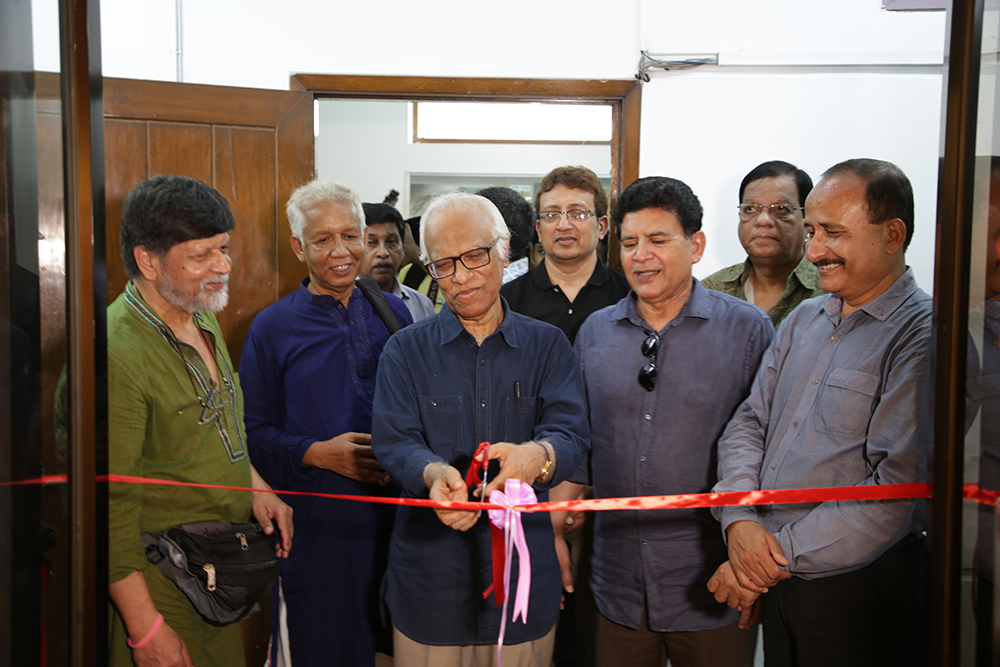
Photography Exhibition: BRATTYAJAN
A photography exhibition, BRATTYAJAN (The Lower Depths) by Philip Gain was organized from 19 to 25 June 2019 at DRIK Gallery, Dhanmondi, Dhaka. The exhibition brought to light the ethnic and tea communities, Bede, sex workers, Kaiputra, Rishi, Harijan, Jaladas and Bihari. They constitute most of the social outcasts and excluded people of Bangladesh. Around 200 images showing the identities, lives and struggles of these communities were on display at the exhibition.
Social Outcasts, Excluded and Marginalized Communities
Prof. Wahiduddin Mahmud is inaugurating the photoraphy exhibition. He is surrounded by (from left) Dr. Shahidul Alam, Moazzem Hossain, Prof. Adnan Zillur Morshed, Dr. Hossain Zillur Rahman, Dr. Harishankar Jaladas and Philip Gain.
There are groups of people and communities that have become victims of discrimination, exploitation and exclusion for generations or for hundreds of years and in some cases for a thousand years. They are spread around the world including Bangladesh. The factors that underlie include the beliefs and disbeliefs in fictional realities (religions), ethnic identities, slavery, occupations, casteism, culture, migration, hatred and geographical locations among others. The people, too weak, marginalized and broken can be called BRATTYAJAN. In Maxim Gorky’s play, The Lower Depths, they are social outcasts and in Hindu casteism or Varna they belong to even below the Shudra or in the fifth Varna. Their capability deprivation is deep-rooted and it is possibly the biggest modern-day challenge for Bangladesh, South Asia and many other countries in the world.
Four organizations implementing the project organized the photography exhibition, BRATTYAJAN (The Lower Depths) by Philip Gain from 19 to 25 June 2019 at DRIK Gallery, Dhanmondi, Dhaka.
The exhibition brought to light the ethnic and tea communities, Bede, sex workers, Kaiputra, Rishi, Harijan, Jaladas and Bihari. They constitute most of the social outcasts and excluded people of Bangladesh. Around 200 images showing the identities, lives and struggles of these communities were on display at the exhibition.
The opening of the photography exhibition was held on 19 June 2019. The participants in the opening session—as many as 150—represented ethnic and marginal communities, anthropologists, architect, film makers, researchers, writers and journalists. Two cultural teams—Garo and Santal, dressed in their traditional outfits danced, sang and beat their drums to welcome the guests. The sound of the drums and their traditional instruments gave a festive look to the opening session. Professor Wahiduddin Mahmud with other dignitaries opened the exhibition.
A panel of experts spoke at the opening session. They shed light on exclusion challenges and the difficulties these communities face in treading the path of development as equal citizens of Bangladesh.
Professor Wahiduddin Mahmud, the chief guest at the opening session, reflected on the condition of the marginal and excluded communities in Bangladesh. “It is very unfortunate that the marginal and excluded communities are undercounted and unnoticed in the government planning, statistics and national census,” remarked Prof. Mahmud. “In the government planning, their rights and social protection are not adequately addressed. Now its time to engage them and ensure equality for all.”
“The main objective of recent economic policy in Bangladesh is that there would be no destitute (Brattyajan) in the country by 2030. The Brattyajan constitutes three to four per cent of the total population. Is it possible to reduce poverty if this number remains unnoticed?” questioned Prof. Mahmud. His reflection was critical in his discussion on environmental pollution as a result of industrialization, urbanization and lucrative development projects. “Saving environmental balance is one of the key objectives of Sustainable Development Goals (SDGs). The life of the ethnic and marginal communities is largely dependent on the environment and forests. It is not possible to achieve SDGs without improving their lives,” warned Dr. Mahmud.
In his introductory remarks, Philip Gain, the photographer of the exhibition and director of SEHD was critical in his reflection on the forest land and its people in Modhupur. “We have displayed images of 115 communities in the exhibition. Among these, 25 exclusive pictures on Modhupur show how monoculture and other factors have changed the landscape and environment of a unique forest that survived thousands of years,” said Gain. “I have travelled quite extensively through the Modhupur forest villages since 1987 and have taken tens of thousands of photos of the devastation of the Modhupur sal forest due to rubber monoculture, social forestry with invasive species and commercial banana, pineapple and spice plantations.”
In reference to a recent household survey of 44 forest villages in Modhupur, Gain informed that 61.11% of the inhabitants in these villages are Bangalees, 33.47% are Garos and 5.42% are Koch. Only 13% of the Bangalee households have title deeds (CS and RoR) for their homestead land, which is only 4.19% for the Garos. For high land where they grow banana, pineapple, spice

and other garden crops only 4.83% Bangalee households and 2.61% Garo households have CS or ROR for their land. For the low land 9.67% Bangalee households and 11.17% Garos households have CS and RoR.
On his experience in work with the tea communities, Gain informed, “We have found 80 communities in the tea gardens. Information about these communities can be found in our book, Slaves in These Times. In the northwest, we have also found 37 ethnic communities, majority of them were not on the government list until recently. Images on all these communities are part of this exhibition.”
The chair of the launch, Dr. Hossain Zillur Rahman, executive chairman of Power and Participation Research Centre (PPRC) and former advisor to the caretaker government, reminded in his remarks, “Documentation is unavoidable to scale up visibility of the marginal communities, who remain out of sight. The lead photographer of the exhibition, Philip Gain has been working restlessly to bring the excluded and marginal people to light. It is now important for all of us to work together to make them visible.” Dr. Rahman stressed on the inclusion of these communities in the eighth five-year plan of the government.
Others who spoke at the launching were Dr. Shahidul Alam, an internationally renowned photographer; Masihuddin Saker, architect and filmmaker; Professor Adnan Zillur Morshed, executive director, Centre for Inclusive Architect and Urbanism, BRAC University; Dr Harishankar Jaladas, writer and novelist; Chitta Ghosh, senior journalist, Bede leader Soud Khan and Moazzem Hossain, chief executive of Gram Bikash Kendra (GBK).
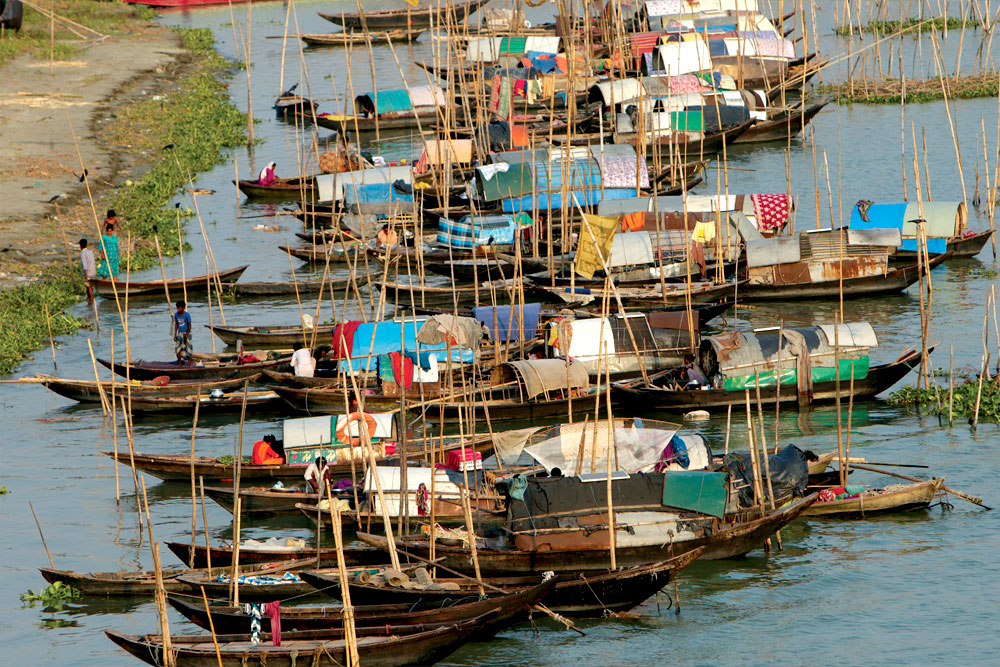
National Convention, Cultural Festival and Photography Exhibition
Four organizations—Power and Participation Research Centre (PPRC), Society for Environment and Human Development (SEHD), Christian Commission for Development in Bangladesh (CCDB) and Gram Bikash Kendra (GBK) are organizing a national convention, photography exhibition and cultural festival from 19 to 25 June.
1. Exhibition-DRIK: Exhibition Launch. English | Exhibition launch. Bangla
2. National Convention-LGED: National Convention. English | National Convention. Bangla
3. Cultural Program: Leaflet English | Leaflet Bangla


